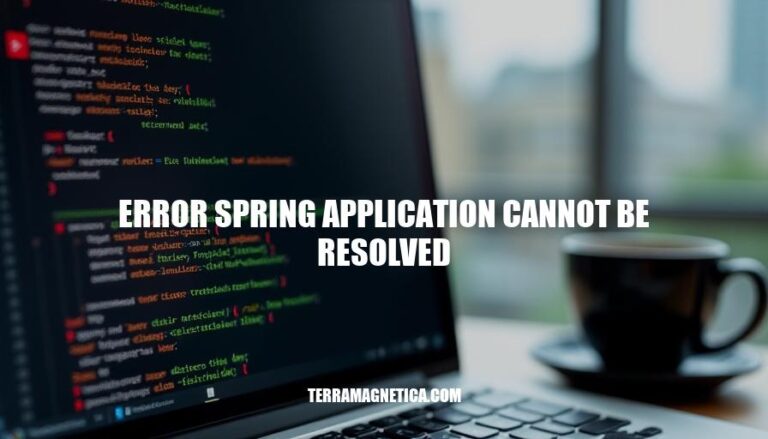


‘Error spring application cannot be resolved’ is one of those cryptic messages in the Spring Framework ecosystem that can cause significant headaches for developers. It pops up when there are problems in the configuration or the dependency injection of a Spring application. This error can bring your application to a halt, preventing it from running correctly or at all.
Identifying and resolving this issue quickly is crucial because it ensures the stability and functionality of your application, maintaining a seamless user experience and smooth development process. Let’s dive into the nitty-gritty of why this happens and how to fix it efficiently.
Dependency Issues: Missing or incorrect dependencies in the project’s build file (e.g., pom.xml for Maven or build.gradle for Gradle) can lead to this error. This can happen if the required libraries are not included or if there are version conflicts between dependencies.
Configuration Errors: Incorrect or missing configuration in the application’s configuration files (e.g., application.properties or application.yml) can cause this error. For example, if a required property is missing or misconfigured, the application context may fail to load.
Missing Beans: If a bean is not properly defined or annotated, the Spring container will not be able to wire it correctly, leading to this error.
This can happen if the @Component, @Repository, @Service, or @Controller annotations are missing from a class that should be managed by Spring.
Package Scanning Issues: If the package scan is not configured correctly, Spring may not be able to find and register beans in certain packages. This can be resolved by configuring the @ComponentScan annotation to include the correct packages.
Unsatisfied Dependencies: This error can occur if a bean has dependencies that are not satisfied. For example, if a service class depends on a repository bean that is not defined or not correctly wired, this error will be thrown.
Classpath Issues: If the required classes or libraries are not available in the classpath, the application context will fail to load.
This can happen if the project structure is incorrect or if there are issues with the build process.
Incorrect Annotation Usage: Using incorrect or missing annotations on classes can lead to this error. For example, if a class that should be a Spring bean is missing the @Component annotation, it will not be detected by the Spring container.
ServletWebServerFactory Bean Missing: In web applications, if the ServletWebServerFactory bean is missing or not correctly configured, the application context will fail to start. This can happen if the required dependencies (e.g., spring-boot-starter-web) are not included in the project.
Non-Unique Dependency Resolution: If there are multiple beans that satisfy a dependency and Spring cannot determine which one to use, this error can occur.
This can be resolved by using @Primary or @Qualifier annotations to specify the desired bean.
Thread Safety Issues: Spring applications are typically multi-threaded, and thread safety issues can cause this error. Ensuring that beans are thread-safe and properly synchronized can help prevent this error.
I hope this helps!
Check Logs: Open your application logs to identify any specific error messages related to the ‘spring application cannot be resolved’ issue. Look for stack traces and error codes that can give you more insight into what might be going wrong.
Verify Configuration Files: Ensure that your application.properties or application.yml files are correctly configured. Check for any typos or incorrect settings that might be causing the issue.
Check Dependencies: Make sure all required dependencies are included in your pom.xml (for Maven) or build.gradle (for Gradle).
Verify that the versions of the dependencies are compatible with your Spring Boot version.
Check Classpath: Ensure that the Spring Boot libraries are correctly added to your project’s classpath. You can do this by checking your IDE’s project structure or build configuration files.
Run with Debugging: Start your application in debug mode to get more detailed information about the error. This can help you pinpoint the exact location where the issue is occurring.
Update Dependencies: If you suspect that a dependency might be causing the issue, try updating it to the latest version.
Sometimes, compatibility issues can cause such errors.
Check for Missing Beans: Ensure that all required beans are correctly defined and wired in your configuration filesFailed to load ApplicationContext in Spring (Boot …. Missing beans can cause the application context to fail to load.
Consult Documentation: Refer to the official Spring Boot documentation or relevant forums for any known issues and solutions related to your specific error.
Search for Similar Issues: Look for similar issues on platforms like Stack Overflow or GitHub. Chances are, someone else has encountered and resolved the same problem.
Rebuild Project: Sometimes, simply rebuilding your project can resolve issues caused by stale or corrupted build files.
Clean and rebuild your project to see if the issue persists.
By following these steps, you should be able to diagnose and fix the ‘spring application cannot be resolved’ error in your Spring Boot application.
Make sure to always update dependencies to their latest stable versions to avoid any compatibility issues. Use a dependency management tool like Maven or Gradle, and regularly check for conflicts and deprecated libraries. Implement continuous integration pipelines for automated testing.
Perform unit, integration, and end-to-end tests to catch issues early. Incorporate static code analysis tools to detect potential problems. Finally, consider using containerization to ensure your application runs in a consistent environment.
can occur due to various reasons such as:
To resolve this issue, follow these steps:
Regularly updating dependencies to their latest stable versions, using dependency management tools, and implementing continuous integration pipelines can help prevent such errors.